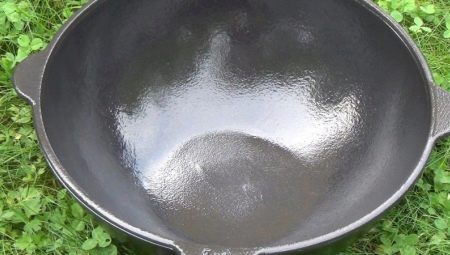Cauldron is a universal type of kitchen utensil and allows you to cook both on the stove and on an open fire. However, the latter method of operation leads to the formation of soot and greasy deposits on the outer walls of the dishes, which is why the cauldron needs more thorough and painstaking care than ordinary kitchen pots and roasters.
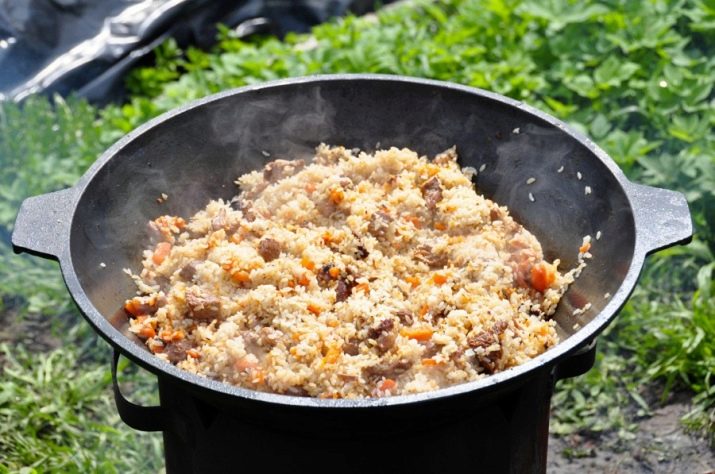
What is a cauldron?
The history of the appearance of the cauldron is rooted in the distant past. The first vessels appeared in the countries of the East and were made of the most accessible material in terms of processing - copper. However, over time and with progress in the processing of harder and stronger metals for the manufacture of cauldrons began to use duralumin alloy and cast iron. These metals differ significantly in physical properties, but both have a high heat capacity. This property, combined with the rather impressive thickness of the walls of the vessel, allows you to deal not only with cooking and stewing, but also languishing, as well as frying a variety of dishes. Thick walls give heat to the products inside for a very long time, which is why the dish is cooked more evenly and has time to be saturated with the aroma of seasonings.
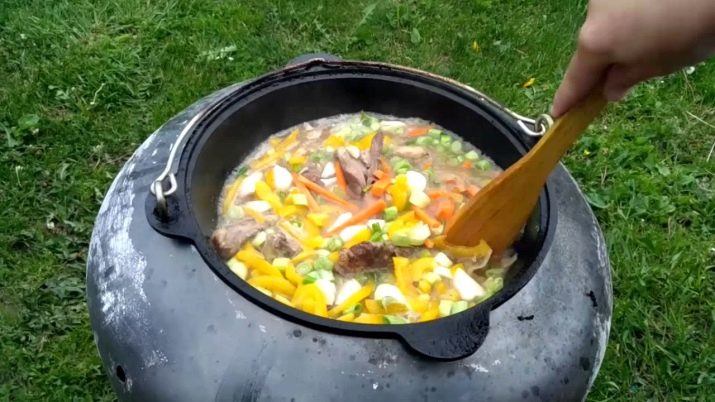
As for the shape of the product, it can be round or elongated and have both a flat and rounded bottom. Flat-bottom models are suitable for use on gas and electric stoves, while products with a round bottom are designed exclusively for open fire. Street cauldrons are installed on portable tandoor, placed on tripods or barbecues, and sometimes even put on hot coals. From the point of view of cooking convenience, rounded dishes compares favorably with traditional models with a flat bottom. This is due to the fact that in round cauldrons it is much more convenient to mix food, moreover, the oil flows evenly along the sloping walls and is less absorbed into the dish. The versatility of the cauldron allows you to cook various sauces in it, stew fish and meat, cook rich soups and cook pilaf.
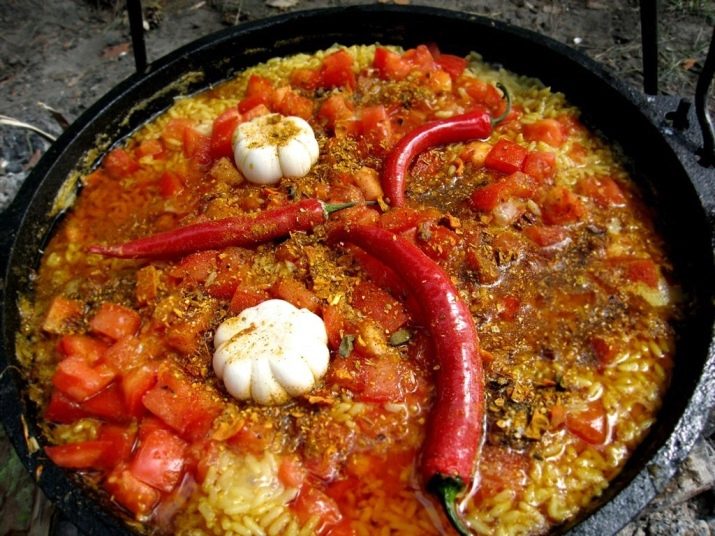
Cleaning methods
The choice of the most effective method for cleaning the cauldron is completely dependent on the material from which it is made.
Aluminum models
Cauldrons made of aluminum are easier to clean than cast iron, which is explained by the less porous structure of the metal. However, an aluminum-based duralumin alloy is susceptible to oxide plaque formation., which appears when a metal comes in contact with oxygen, which is part of the air. Fighting a raid is easy. To do this, regularly clean the dishes with a soft metal sponge and abrasive detergent.
The use of hard sponges is unacceptable, since they leave deep scratches on the soft metal, in which food particles accumulate on the inside and droplets of fat and soot from the outside.
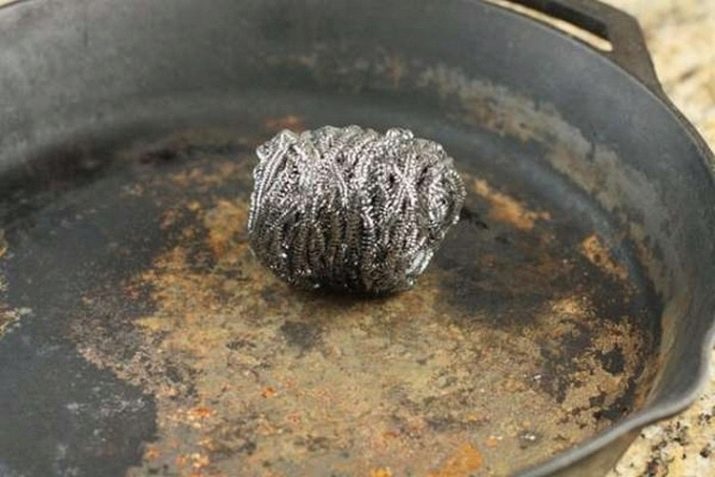
In order to clean the aluminum cauldron of soot and soot, use a large basin in which water is poured and 500 grams of soda ash, a piece of grated laundry soap and a couple of bottles of silicate glue are added. Then the container is put on fire, the components mix well. After they completely dissolve, put a dirty cauldron there. Boil the dish should be at least 25 minutes by opening the window in advance or by turning on the hood. Such a measure is necessary to eliminate the unpleasant odor that will come from dissolving old fat. Then the cauldron is removed, the fat is rubbed with a sponge of medium hardness using a dishwashing gel and rinsed.
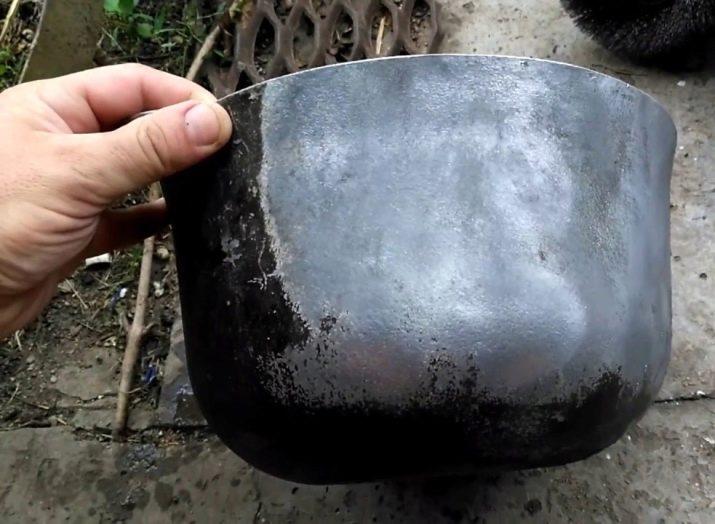
However, if a large basin where the cauldron could fit was not available, then you can use the bath. For this, hot water is drawn into it, bleaching powder is poured and dishwashing liquid is poured. A cauldron is placed in water so that all contaminated places are hidden under water, and then left overnight. In the morning, the product is washed with a metal sponge using a liquid and rinsed well.
The following method will help remove dirt from the inner walls of the cauldron. To do this, it is enough to pour soap-soda solution into the vessel and boil it for 15–20 minutes. The composition is prepared in the following proportion: 5 l of water, 5 g of laundry soap and 2 tbsp. l baking soda or soda ash. In field conditions, cleaning the cauldron is even easier. A little water is poured into it, brought to a boil, the impurities present on the walls are moistened and sprinkled with salt. After the water in the cauldron cools down a little and becomes tolerable for hands, the cauldron is tipped and the dirt is washed off the walls with a metal sponge.
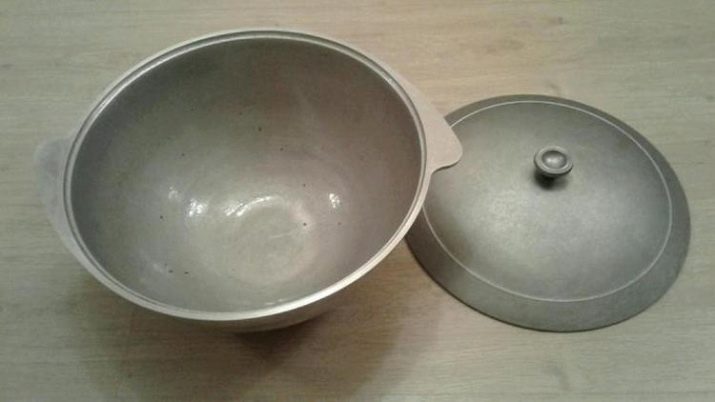
When cleaning an aluminum cauldron, it is important to remember that it is strictly forbidden to calcine it, since aluminum does not tolerate strong heating and can be deformed. If dark spots appear on the aluminum cauldron over time, then 6% vinegar will help to cope with them, in which they wet the napkin and wipe the darkened areas. In case of burning food, salt, soda and citric acid are poured into the vessel in a ratio of 1: 1: 1, a little water is poured and boiled for 20 minutes. A similar effect has a mixture of 1/3 of a bar of soap, a spoon of ammonia and a couple of liters of water. The resulting solution is also poured into a cauldron and boiled for 20 minutes.
It’s a little harder to deal with rust, which affects the metal during improper storage of the cauldron. To do this, the vessel is soaked in a solution of water and vinegar, taken in equal parts, and then with a metal sponge, a rusty coating is scraped off.If the corrosion process was found at the very beginning, then you can do without boiling. To do this, take coarse sandpaper and clean off the rust. Then, fine-grained sandpaper is passed through the cleaned areas, after which they wash the dishes with a liquid and rinse.
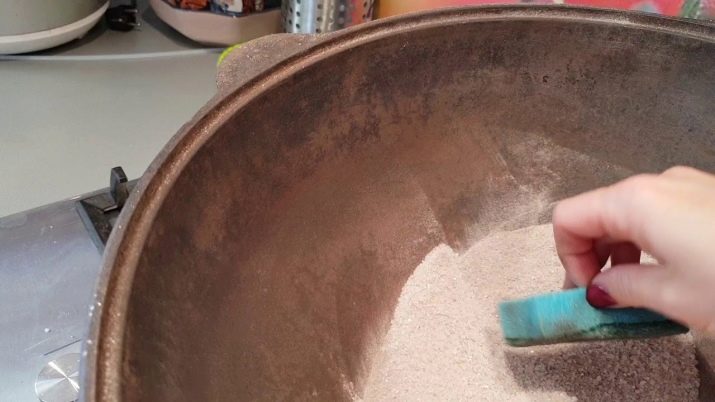
Cast Iron Cauldron
Products made of cast iron should be handled especially carefully. Despite the apparent power and thickness, cast iron is a fairly brittle metal and can crack when dropped. At the production stage, cast-iron models go through the burnishing or oil firing stage, which leads to the creation of non-stick and anti-corrosion layer. Therefore, it is desirable that the cast iron products are not subjected to scratching, as a result of which the protective layer is broken, and the product begins to rust. Both internal and external pollution from cast-iron models are eliminated by the same methods as from aluminum, and involve the use of already known components: salt, soda, silicate glue and laundry soap.
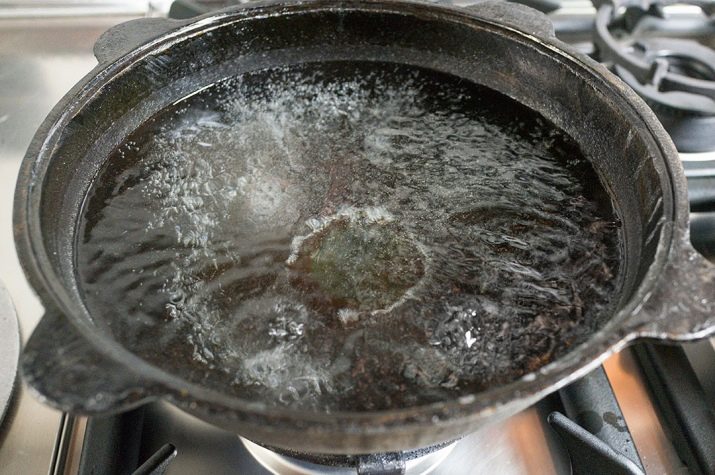
However, unlike aluminum models, cast iron products can be calcined. For this, the cauldron is placed in the oven and heated to 300 degrees. After 10 minutes, the container is removed, greased on all sides with oil and sent to the oven for half an hour. This procedure will help to restore the lost properties of the protective layer and prevent corrosion.
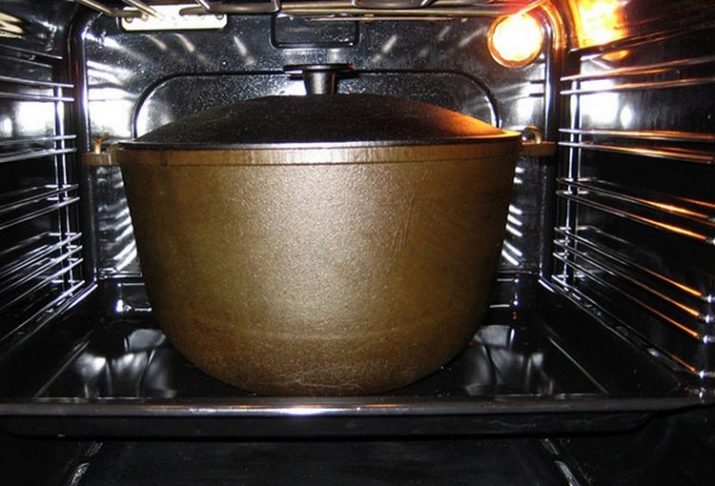
For cleaning cast iron cauldrons, as well as for aluminum, you can use household chemicals. Good results on the removal of burnt food gives processing compounds for ovens and cooker hoods, which are very effective in dealing with old fat and soot.
In field conditions, you can clean the cast iron model as follows: The cauldron is filled to the brim with river sand and hung over a fire. After a few hours, empty the vessel and rinse it. Instead of sand, you can use table salt, 2 kg of which is poured into a cauldron and for 2 hours (stirring) well calcined on a stove. At the end of the procedure, the salt will darken and the cauldron will be cleaned.
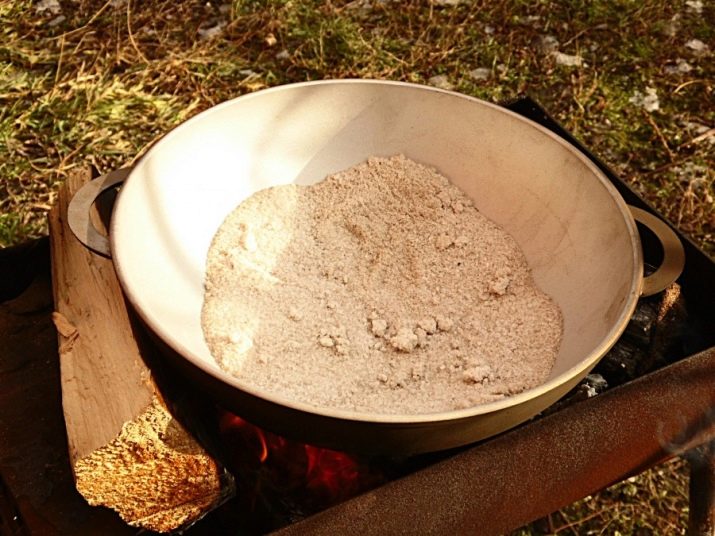
The following method of cleaning cast iron is also effective, however, after its use, the cauldron needs a mandatory 3-5-fold calcination using vegetable oil. So, pour 1/2 cup of dry mustard powder and citric acid in an amount of 40 g into a cauldron, pour 1 liter of water and boil for 20 minutes. Then they wait until the solution cools down a little and with the help of a soft metal sponge they clean the inner walls of the cauldron. Then the product is rinsed, wiped dry and calcined.
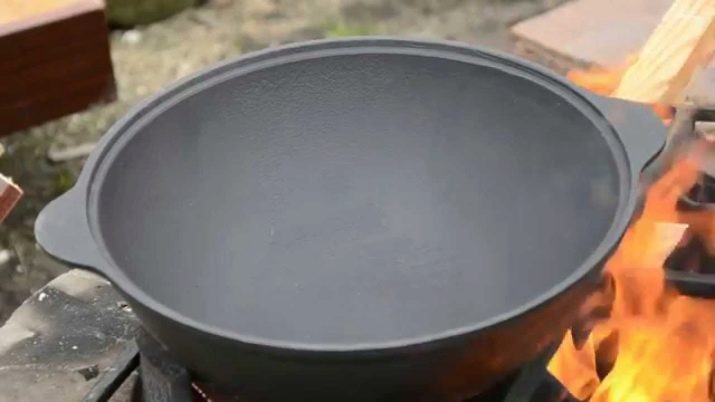
Storage rules
After each use, the aluminum models must be thoroughly washed with a degreasing agent, rinsed well and wiped dry. Such products should be stored in a dry and well-ventilated area, since the aluminum surface can become a breeding ground for the fungus.
Cast iron models should also be thoroughly washed after each use, wiped well and protected from excessive moisture.
For long-term storage, it is recommended to wrap the cast-iron cauldron in oiled cotton or linen cloth and put it in a dry place.
Instead of fabric, you can use oiled paper - it will also protect the product from moisture and prevent rust.
As you can see, caring for a cauldron at home is not difficult. The main thing is to clean it in time and prevent old pollution. And then, sparkling and pure, he will serve his owners for a long time.
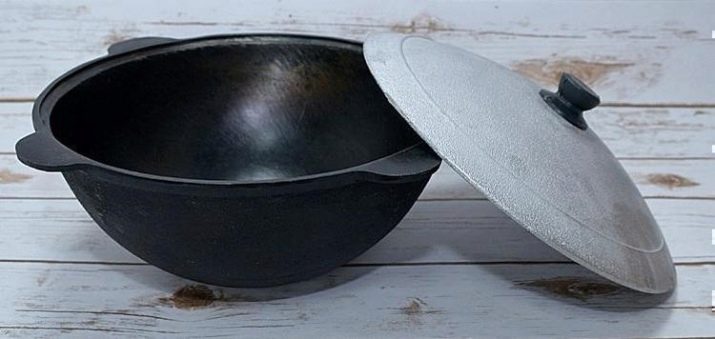
See how to wash the cast iron cauldron and how in the next video.
